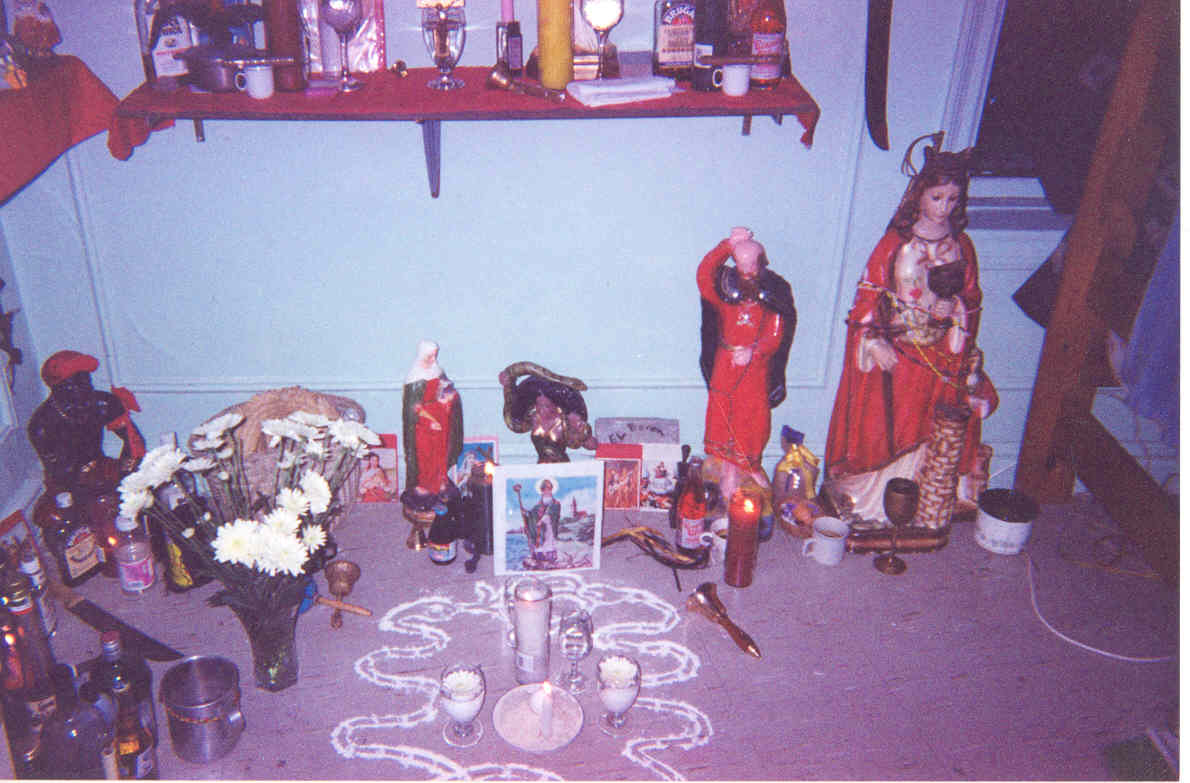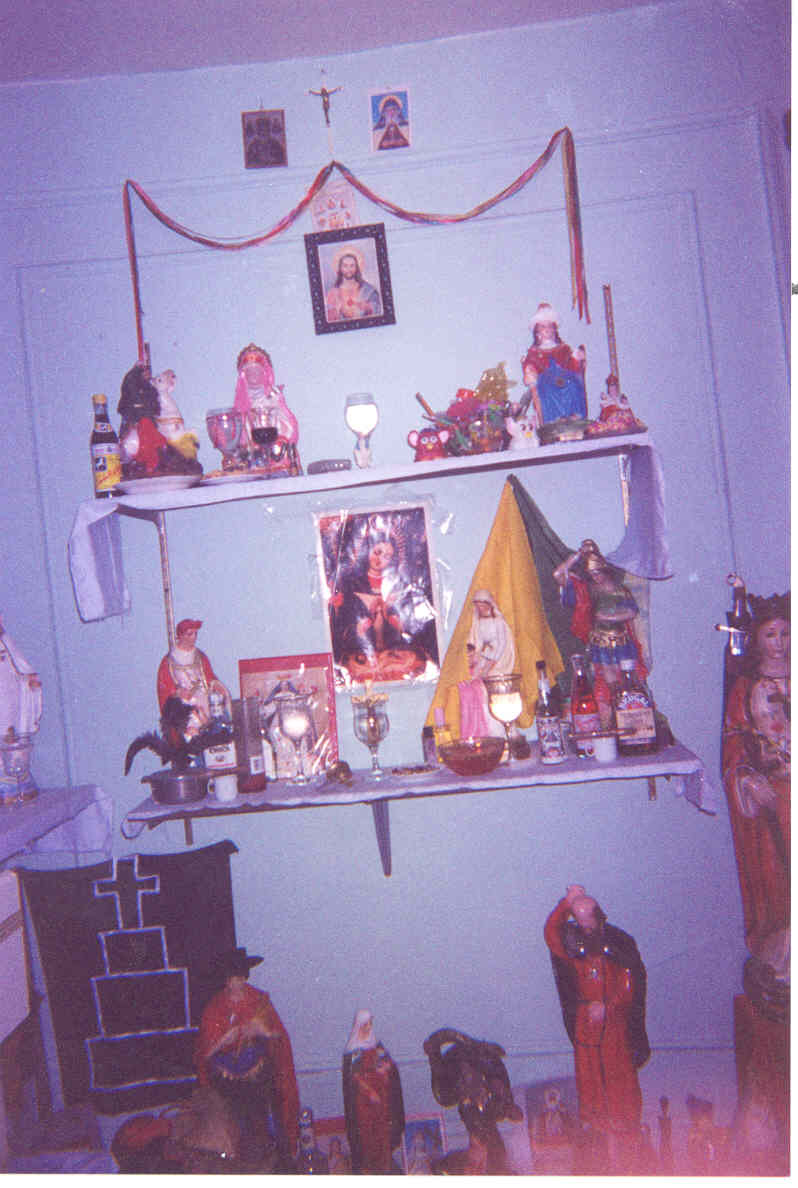 The Loas (also spelled Lwas) are the spirits of Vodou. They are the Spirits that comprise the 21 Divisions. Each one of them has his or her own attributes, colours and drinks. The Loas or (Misterios--meaning Mysteries--as they are called in Spanish), are the spirits of those who once lived.
The Loas (also spelled Lwas) are the spirits of Vodou. They are the Spirits that comprise the 21 Divisions. Each one of them has his or her own attributes, colours and drinks. The Loas or (Misterios--meaning Mysteries--as they are called in Spanish), are the spirits of those who once lived.
The origin of the Loas is rather a matter of argument. Some believe they all come from Haiti, others that some came from Africa. Yet to my knowledge, these spirits do infact come from Africa. They are the spirits of slaves. Guinea is the country from where all originated. The Fon people, or Dahomey, are the ones responsible for us having these spirits now in days. Dahomey is a country in West central Africa on the gulf of Guinea, a former French colony. It is from this region that it is truly believed that these spirits actually came from; atleast most of the Rada Loas.
Now one may wonder how did these spirits get here form such far away and to most of Latin America ? The answer is quite simple: the slave trade. After Europe had conquered most of Africa, they (the Europeans) shipped Africans to most of "The New World". The Africans arrived to these islands bringing with them most of there traditions and costumes. Of course the white man forced the African into Christianity (namely Catholicism).
From there is where the syncretism of the African spirits to Catholic Saints came from.
As the various African families were scattered throughout the New World by the slave trade, their religious practices were influenced by their new surroundings and strange languages spoken in the lands of their exile. Each tribe borrowed freely from the costumes, the ideas, and the religious beliefs of its adopted land. This brought great diversity into the magickal ceremonies of the African man. The rites varied with each tribe.
In Haiti, the Vodou religion was propagated by the Nagos, the Ibos the Aradas and the Dahomey, as well as other tribes. In the Spanish and Portuguese colonies, especially Cuba and Brazil, similar rites were brought by the Yoruba people. Although some of the rituals inHaitian Vodou (and therefore Dominican Vodou and Santeria) are not to different, the divergences are marked. For not only were different tribes involved in two movements, but also Haiti was under French control during the slave trade; wile other Caribbean countries, such as Cuba, Puerto Rico and the Dominican Republic were under Spanish rule.
 In Haiti were Vodou has strongly flourished, the exiled slaves were deeply influenced by the Catholic iconography of their French masters. In their confused imagery, they identified their spirits with the Saints of the Catholic Church. This was the beginning of the syncretism of the religion. This syncretism can be greatly seen in that most of the Loas have been identified with the images of the Catholic Saints.
In Haiti were Vodou has strongly flourished, the exiled slaves were deeply influenced by the Catholic iconography of their French masters. In their confused imagery, they identified their spirits with the Saints of the Catholic Church. This was the beginning of the syncretism of the religion. This syncretism can be greatly seen in that most of the Loas have been identified with the images of the Catholic Saints.
To the Catholic worshiper, the image of a Saint is a representation of a spiritual being who lived at one time upon the Earth as a human being. To the practitioner of these religions, the image is an "embodiment" of their spirits.
The white man might have seen one of his slaves praying to the Virgin Mary, yet little did he know that, that slave was infact praying to his spiritual mother Erizulie. Now a days just because one may be a practitioner of any one of the African religions mentioned above does not mean that one may find that same person at a Catholic mass. Be it to get some Holy water for a spiritual bath, or simply just to listen to the Fathers sermon; Vodou does not go against the teachings of the Catholic church, nor does it wish to do so. It is a religion all of its own.
The different groups of Loas in Dominican Vodou can be divided into three rites, better known as Divisions-the 21 Divisions. While in all there is a total of twenty-one groups of Loas, we divide out Loas into three "major" divisions: the White, Black and Indian divisions.
 The Loas (also spelled Lwas) are the spirits of Vodou. They are the Spirits that comprise the 21 Divisions. Each one of them has his or her own attributes, colours and drinks. The Loas or (Misterios--meaning Mysteries--as they are called in Spanish), are the spirits of those who once lived.
The Loas (also spelled Lwas) are the spirits of Vodou. They are the Spirits that comprise the 21 Divisions. Each one of them has his or her own attributes, colours and drinks. The Loas or (Misterios--meaning Mysteries--as they are called in Spanish), are the spirits of those who once lived.
 In Haiti were Vodou has strongly flourished, the exiled slaves were deeply influenced by the Catholic iconography of their French masters. In their confused imagery, they identified their spirits with the Saints of the Catholic Church. This was the beginning of the syncretism of the religion. This syncretism can be greatly seen in that most of the Loas have been identified with the images of the Catholic Saints.
In Haiti were Vodou has strongly flourished, the exiled slaves were deeply influenced by the Catholic iconography of their French masters. In their confused imagery, they identified their spirits with the Saints of the Catholic Church. This was the beginning of the syncretism of the religion. This syncretism can be greatly seen in that most of the Loas have been identified with the images of the Catholic Saints.

